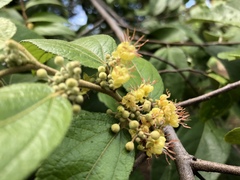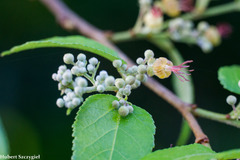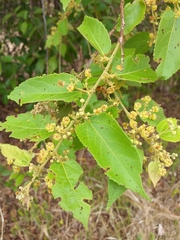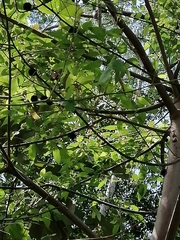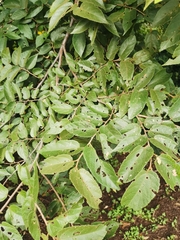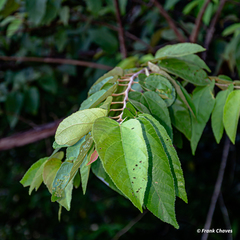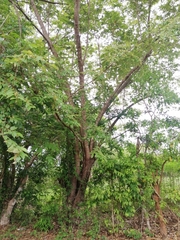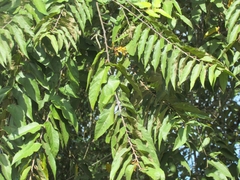

|
|
|
|
Family: Sterculiaceae
Bastard-Cedar, more...pricklenut (es: guásima, guácima, caulote, majagua del toro, palote negro, tapaculo, vacima, guácimo, guácimo ternero)
[Guazuma ulmifolia var. tomentosa (Kunth) K. Schum.] |
Description: A medium-sized tree, usually with many branches near the ground (but rare forest individuals grow straight and tall). Leaves are alternate, in flat plane along long branches; upperside dark green, underside light green-blue. Leaf base is decidedly asymmetric, and leaves are rough (asperous) to the touch. There are three main leaf veins arising together from the leaf base, a characteristic of this family as well as several related families (Bombacaceae, Malvaceae, Tiliaceae). Reproduction: Produces small, whitish-cream flowers during the dry season. These develop into odd, woody fruits that are almost reminscent of a tiny pine cone (or alder cones). But the fruits have a cherry flavor if chewed. Fruits are green when immature, becoming black, produced through much of the wet seas Distribution: A very common tree of farmland, sometimes forming nearly pure stands in abandoned pasture. There are many along the road from Panama to Gamboa, and quite a few in Gamboa. Fairly common inside secondary forest, and, remarkably, there are few individuals in the old forest on Barro Colorado Island. Similar Species: Not hard to learn because of its abundance in residential areas, the asymmetric leaf base and asperous feel should pin it down. When fruits are present, they cinch the identification, since no other species has anything similar. LK muntca Muntingia calabura LK2 also grows in pasture and abandoned farmland, and has similar leaves with an asymmetric base; but Muntingia has softer leaves with a lighter underside, and usually has white flowers that are much larger than Guazuma's. Descripción: Árbol de 10 a 25 m de alto. Tronco con raíces tablares pequeñas en la base. Corteza exterior fisurada y de color negro. Ramitas terminales cilíndricas y con pelos estrellados, visibles con una lupa. Al quebrar las ramitas la corteza se desprende en tiras largas y exuda una savia mucilaginosa. Hojas simples y alternas, muy variables en forma y tamaño, pero generalmente alcanzan de 3-16 x 2-7 cm, lanceoladas, con ápice acuminado, bordes dentados y base cordada o desigual. Las hojas presentan de 3-7 nervaduras principales saliendo desde la base. Estípulas pequeñas y deciduas, pero persistentes en los ápices de las ramitas. Pecíolo de 0.5-1.2 cm de largo y pulvinado en el ápice. Flores amarillas y pequeñas. Frutos en cápsulas oblongas y globosas, de 1.8-2.5 cm de largo, verdes y cubiertos de pequeñas protuberancias cónicas en el exterior, tornándose negros y dehiscentes al madurar. Datos Ecológicos: La especie crece a bajas y medianas elevaciones, en bosques secos o húmedos de todo el país. Común en pastizales y áreas secas de la vertiente del Pacífico en Panamá, pero raro o ausente en bosques lluviosos del Caribe. Deja caer parcialmente sus hojas durante la estación seca, pero las repone a inicios de la estación lluviosa. Florece y fructifica de enero a julio. Las flores son visitadas por abejas y otros insectos. Especies Parecidas: A menudo se confunde con LK tremmi Trema micrantha LK2 , pero en Trema las hojas son ásperas al tacto y los frutos son drupas pequeñas. También se puede confundir con LK muntca Muntingia calabura LK2 , pero en M. calabura el envés de las hojas es blanco o gris y los frutos son bayas globosas. Usos: La madera es empleada en construcciones internas, postes de cercas y leña. La corteza, hojas, flores y frutos tienen uso medicinal contra la fiebre, vómito, gastritis, diabetes y las erupciones epiteliales. En otros países los frutos se han utilizado en la elaboración de sirope para la industria del azúcar. Los árboles de guácimo sirven como forraje para el ganado, crecen rápido y pueden emplearse en plantaciones mixtas para la recuperación de áreas degradadas. Las flores son visitadas por abejas, de allí que los árboles de esta especie se pueden emplear como planta melífera en fincas dedicadas a la apicultura. Lam., Encycl. Méth. Bot. 3:52.1789 Tree, generally 6-25 m tall; trunk to 60 cm dbh; stems, petioles, lower leaf surfaces, and axes of inflorescences densely stellate-tomentose. Stipules minute, caducous; petioles 5-20 mm long; blades lanceolate, acuminate, rounded to cordate and oblique at base, 6-16 cm long, 2-6 cm wide, glabrate or more often stellate-puberulent on both surfaces, the margins irregularly and finely toothed; palmate veins at base 3-7. Flowers in short, loose, axillary, thyrsiform clusters; pedicels 3-6 mm long; sepals 3, yellow, unequal, stellate-puberulent outside, recurved at anthesis; petals 5, obovate, ca 2.5 mm high, yellowish-green, hooded and bifid at apex, fused to free part of filament, the claw red with several red lines extending up petals, the appendage of the petal deeply bifid, ca 4 mm long; stamens 15, in 5 groups of 3 each, opposite petals, the staminal tube minute, red; pistil minute; staminodia 5, triangular, alternate with petals. Fruits globose to oval, 2-4 cm long, indehiscent or opening partway along 4 or 5, +/- regular, longitudinal fissures, covered with many stout brown tubercles, the tubercles separating at maturity to expose the irregularly porate white surface; seeds numerous, irregularly ovoid, 2.5-3.5 mm long, borne among the fibrous inner parts, apparently falling through the holes in the exocarp, the testa maculate, covered by a membrane, the membrane very thin, mucilaginous and very sticky when wet. Croat 6780, 8484. Uncommon, in the forest and at the edge of the Laboratory Clearing. Flowers mostly from March to May and from September to November. The fruits have been seen from March to May and in September. |















